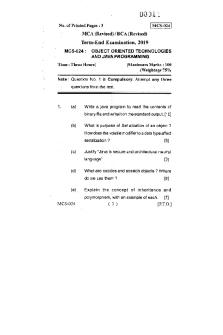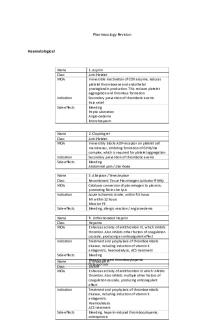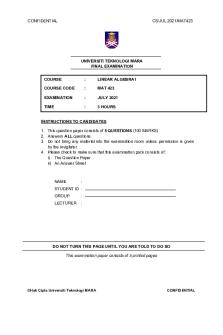MBChB 3rd year Past Paper Neurology Questions PDF

| Title | MBChB 3rd year Past Paper Neurology Questions |
|---|---|
| Course | MBCHB 3rd Year |
| Institution | University of Glasgow |
| Pages | 40 |
| File Size | 1.2 MB |
| File Type | |
| Total Downloads | 4 |
| Total Views | 168 |
Summary
Questions on neurology without answers...
Description
2008 Registration (Matriculation) Number_______________Candidate Number_____
MODIFIED ESSAY QUESTION B
30 MARKS
PATIENT 1
(15 marks)
A 25-year-old electrician, Mr B.S., is brought to the Accident and Emergency Department in a dishevelled state. He looks frightened and distracted and has told nursing staff that aliens can hear his conversations and are trying to harm him. You think that he may have schizophrenia. B(i)
Name TWO other conditions that may present in this way
(1 mark)
Once you have assessed the patient, and spoken to his family, you confirm your provisional diagnosis of schizophrenia. B(ii)
List FOUR of the main symptoms found in this condition.
23
(2 marks)
Continued overleaf
Registration (Matriculation) Number_______________Candidate Number_____ MODIFIED ESSAY QUESTION B Patient 1 (cont) B(iii) Explain the disturbance in brain function believed to be responsible for schizophrenia. (3marks)
B(iv) Describe the neuropathological changes which are found in some cases of schizophrenia. (2 marks)
B(v)
List ONE drug from each of the TWO main categories of drugs used to treat this condition. (1 mark)
Category
Drug
Mark
Typical antipsychotic
½
Atypical antipsychotic
½
24
Continued overleaf
Registration (Matriculation) Number_______________Candidate Number_____ MODIFIED ESSAY QUESTION B Patient 1 (cont) B(vi) Name TWO of the common acute side effects of the drugs used in this condition. (2 marks)
B(vii) What long-term side-effect can be caused by these antipsychotics? (1 mark)
B (viii) Describe THREE important issues that need to be considered in the longterm management of this man. (3 marks)
25
Continued overleaf
2010 Registration (Matriculation) Number:____________Candidate Number:__________
SHORT NOTES QUESTION 4
20 MARKS
Mrs H, a 70-year-old widow, is discovered unconscious in bed by her son when he visits her unexpectedly one evening. There is no suicide note and the house appears tidy. Her will is on the mantelpiece and an empty bottle of diazepam is lying on the bedside table. On recovery in hospital she gives a history of gradually becoming more withdrawn, losing weight, feeling a burden on her family and visiting her doctor frequently seeking reassurance that she does not have a malignancy. She has a past history of hypertension and maturity onset diabetes mellitus. Her son has been concerned about her becoming forgetful, occasionally leaving the front door ajar, and more recently she accused her neighbours of spying on her. She has never taken an overdose before, as far as her son knows. On examination she is profusely apologetic for causing “so much bother”. She is reluctant to accept suicidal intent, stating that she just needed some sleep. She appears withdrawn and agitated with somatic preoccupation and her mood is low. Please answer ALL five parts of this question: i)
List the features for and against this being a serious suicide attempt. (5 marks) 1 mark for each correct statement
3
Continued overleaf
Registration (Matriculation) Number:____________Candidate Number:__________
SHORT NOTES QUESTION 4 (continued) (ii)
List six features that support severe depression as the underlying diagnosis (3 marks) ½ mark per correct item to maximum of 3 marks
(iii)
Name two other underlying diagnoses that could be considered in this patient’s case and justify your choices in each case. (2 marks) ½ mark for a diagnosis and ½ mark for a justifying feature
4
Continued overleaf
Registration (Matriculation) Number:____________Candidate Number:__________
SHORT NOTES QUESTION 4 (continued) (iv)
List the factors that you would take into account in deciding whether or not it is safe to send such a patient home eventually. (5 marks) ½ mark for each correct consideration
5
Continued overleaf
Registration (Matriculation) Number:____________Candidate Number:__________
SHORT NOTES QUESTION 4 (continued) (v)
If depression is the underlying diagnosis, name one drug that could be used to treat the depression and name the class of drugs to which it belongs. Describe its mode of action and two possible side effects (5 marks) Name of drug – 1 mark, Class of drug – 1 mark Mode of action – 1 mark Side effects – 2 marks
6
Continued overleaf
2010
Registration (Matriculation) Number:___________Candidate Number:_________
MODIFIED ESSAY QUESTION B
30 MARKS
PATIENT 1
(15 marks)
You are the junior doctor on duty one Sunday afternoon when a 47-year-old sales executive is brought to the Accident & Emergency (A & E) Department by the paramedics. He had suddenly ‘collapsed’, lost consciousness and ‘convulsed’ whilst on the 13th hole at a nearby golf course. Nothing like this has ever happened to him before. You remember that idiopathic epilepsy rarely presents for the first time in someone of this age. B(i)
List SIX possible causes of this episode OTHER than epilepsy that need to be considered also. (3 marks)
On arrival in A&E the patient is alert, well oriented and somewhat embarrassed by all the fuss that he has caused. His friends describe him as having been unconscious and shaking for about 3 minutes and very sleepy for a further 15 minutes. He is normally fit and active and has never been in hospital before.
21
Continued overleaf
Registration (Matriculation) Number:___________Candidate Number:_________
MODIFIED ESSAY QUESTION B Patient 1 (continued) B(ii)
What SIX measurements/observations/investigations should be done in the A & E department? (3 marks)
All of these tests were within normal limits as was a MRI (Magnetic Resonance Image) of the patient’s head carried out the following week. The patient was discharged, but had a second episode of loss of consciousness 3 months later whilst watching TV at home with his family. His wife witnessed the episode and noticed that his eyes were open during the attack and he had jerking movements of his limbs. When he woke up several minutes later he seemed a little ‘confused’. This time, however, his mother was also present and confessed to the family that the patient had had these funny turns before in childhood. He ‘grew out of them’. A neurologist at the local hospital subsequently diagnosed primary generalised epilepsy.
22
Continued overleaf
Registration (Matriculation) Number:___________Candidate Number:_________
MODIFIED ESSAY QUESTION B Patient 1 (continued) B(iii)
List the TWO main categories in the classification of epilepsy. (2 marks)
B(iv)
Under normal conditions what ion movements would cause cortical cells to become excited? (1 mark)
After discussion with the patient it is decided to start medical treatment. B(v)
Name TWO drugs that may be used in the treatment of primary generalised epilepsy. (2 marks)
At the same time the patient is given an appointment to see the epilepsy nurse specialist.
23
Continued overleaf
Registration (Matriculation) Number:___________Candidate Number:_________
MODIFIED ESSAY QUESTION B Patient 1 (continued) B(vi)
Describe EIGHT areas that the patient and the epilepsy nurse might discuss relevant to lifestyle issues in an adult diagnosed as having generalised seizures. (4 marks)
24
Continued overleaf
2010
Registration (Matriculation) Number___________________ Candidate Number______
SHORT NOTES QUESTION 4 (i)
20 MARKS
Describe five causes of delirium and five causes of dementia. (5 marks)
(ii)
Describe five clinical features of delirium and five clinical features of dementia. (5 marks)
(iii)
Describe five investigations that might be carried out for delirium / dementia and briefly explain the relevance of each investigation. (5 marks)
(iv)
Describe five aspects of management of delirium and five aspects of management of dementia. (5 marks)
NB:
Please write your answers in the appropriate tables provided IN THE FOLLOWING PAGES overleaf:
3
Continued overleaf
Registration (Matriculation) Number___________________ Candidate Number______
SHORT NOTES QUESTION 4 (continued) (i)
Describe five causes of delirium and five causes of dementia. (5 marks)
Delirium (½ mark each to a maximum of 2½ marks)
Dementia (½ mark each to a maximum of 2½ marks)
4
Continued overleaf
Registration (Matriculation) Number___________________ Candidate Number______
SHORT NOTES QUESTION 4 (continued) (ii)
Describe five clinical features of delirium and five clinical features of dementia. (5 marks)
Delirium (½ mark each to a maximum of 2½ marks)
Dementia (½ mark each to a maximum of 2½ marks)
5
Continued overleaf
Registration (Matriculation) Number___________________ Candidate Number______
SHORT NOTES QUESTION 4 (continued) (iii)
Describe five investigations that might be carried out for delirium / dementia and briefly explain the relevance of each investigation. (5 marks)
Five investigations for delirium / dementia (½ mark each to a maximum of 2 ½ marks)
Relevance of each investigation (½ mark each to a maximum of 2 ½ marks)
6
Continued overleaf
Registration (Matriculation) Number___________________ Candidate Number______
SHORT NOTES QUESTION 4 (continued) (iv)
Describe five aspects of management of delirium and five aspects of management of dementia. (5 marks)
Delirium (½ mark each to a maximum of 2½ marks)
Dementia (½ mark each to a maximum of 2½ marks)
7
Continued overleaf
2010 Registration (Matriculation) Number___________________ Candidate Number______
MODIFIED ESSAY QUESTION B (continued)
PATIENT 2
(10 marks)
Another patient admitted that day to the Acute Receiving Complex, 65-yearold Mrs R. S., also had a movement problem – but not due to alcohol. She has a definite tremor sitting at rest and a provisional diagnosis of Parkinson's disease has been made. B(viii) List and briefly describe the three broad clinical signs that should be present to make this diagnosis. (3 marks)
B (ix) Name four conditions most commonly misdiagnosed as idiopathic Parkinson’s disease. (2 marks)
28
Continued overleaf
Registration (Matriculation) Number___________________ Candidate Number______
MODIFIED ESSAY QUESTION B Patient 2 (continued)
B(x)
Outline the current theories of the pathophysiology of Parkinson's disease. (3 marks) Examiner’s discretion, approximately ½ mark per co rrect item, up to 3 marks
29
Continued overleaf
Registration (Matriculation) Number___________________ Candidate Number______
MODIFIED ESSAY QUESTION B Patient 2 (continued) You ask the patient about the tremor and she tells you that she has been on Selegiline for the past year. B(xi) Describe how Selegiline works.
(1 mark)
B(xii) Name ONE other drug that is of use in the management of Parkinson’s disease. (1 mark)
30
END
2011 Registration (Matriculation) Number:__________Candidate Number:__________
MODIFIED ESSAY QUESTION C
(30 MARKS)
THE SCENARIO A 67-year-old man, Mr J.D., is brought into the A&E (Accident & Emergency) Department from his home with a two-hour history of marked weakness affecting predominantly the left side of his face and left arm and to a lesser extent the left leg. He pays no attention to the affected side. His speech is slurred and he has difficulty in swallowing. A diagnosis of acute stroke is suspected. C(i)
List six risk factors for stroke.
(3 marks)
C(ii)
In this patient, which side of the brain is affected?
(½ mark)
Registration (Matriculation) Number:__________Candidate Number:__________
MODIFIED ESSAY QUESTION C (continued) A schematic drawing of the arrangement of arterial vessels on the base of the brain, viewed from below, is shown: C(iii) Please name each of the five arteries marked A to E on the diagram. Please write your answers in the table below (2½ marks)
A
½ mark
B
½ mark
C
½ mark
D
½ mark
E
½ mark
Registration (Matriculation) Number:__________Candidate Number:__________
MODIFIED ESSAY QUESTION C (continued) C(iv) State two arteries that might be affected in this patient
C(v)
(1 mark)
The effects of a stroke vary according to the site of the main lesion. What clinical effects would you expect from lesions at the following three sites? Specify where appropriate whether the effects would be right-or left-sided. (6 marks)
Site Left internal capsule
Clinical Effects
Mark 2 marks
Right occipital cortex
2 marks
Left cerebellum
2 marks
Registration (Matriculation) Number:__________Candidate Number:__________
MODIFIED ESSAY QUESTION C (continued) C(vi) Name THREE investigations that should be carried out as soon as possible in order to establish the likely cause of Mr J. D.’s stroke. Explain the reason for each procedure. (6 marks) Any three of the following pairs: Procedure
Mark 1
Reason for procedure
Mark 1
1
1
1
1
Investigation revealed a large cerebral infarct with no evidence of haemorrhage. The patient’s blood pressure was 180/92 mmHg. C(vii) Name two drugs that might be used at this early stage in the management of this patient and say why each might be used. (2 marks) Drug
Mark ½
½
Reason for use
Mark ½
½
Registration (Matriculation) Number:__________Candidate Number:__________
MODIFIED ESSAY QUESTION C (continued)
Three weeks later Mr J.D.’s condition has stabilised. He has improved substantially in that he can now get out of bed onto a chair and feed himself without difficulty. He is no longer dysarthric. His general mobility remains poor. His family are very keen for him to go home. Before discharge it is essential to ensure that his drug therapy is appropriate. C(viii) List THREE classes of drug that might be appropriate on discharge for secondary prevention (i.e. prevention of further strokes), explain why each might be used and give one example of each. (6 marks) Any three sets of the following: Class of drug
Mark
Reason for use
Mark
Example
Mark
1
½
½
1
½
½
1
½
½
The patient is seen at the follow up outpatient clinic for review three months later.
Registration (Matriculation) Number:__________Candidate Number:__________
MODIFIED ESSAY QUESTION C (continued)
C(ix) Compare the clinical features most likely to be found now (after three months) on examination of his left leg, which is still weak, with those that would have been present when first admitted (3 marks)
First Day Tone
Mark ½
3 Months later
Mark ½
Reflexes
½
½
Plantars
½
½
2011 Registration (Matriculation) Number:________________
MODIFIED ESSAY QUESTION B PATIENT 1
Candidate Number:_________
TOTAL 30 MARKS (18 marks)
A 21-year-old lady attends her General Practitioner. She has a 6-month-old daughter and has recently separated from the child’s father. She complains of feeling sad most of the time, and you suspect a depressive illness. B(i)
Name FOUR other conditions which could possibly cause her low mood. (2 marks)
After assessment you conclude she has a depressive illness without psychosis. B(ii)
Name SIX other symptoms that may be present in this condition. (4 marks)
23
Continued overleaf
Registration (Matriculation) Number:________________
Candidate Number:_________
MODIFIED ESSAY QUESTION B PATIENT 1 (continued)
B(iii) Describe the neurochemical dysfunction suspected of causing depressive illness. (2 marks)
You wonder about the possibility of suicidal thoughts and ask some important questions.
B(iv) List FOUR factors which, if present in any patient, would increase the risk of completed suicide. (4 marks)
No self-harming thoughts are present in this lady. There are no concerns about the welfare of the baby. She is not breast-feeding. It is decided to start her on antidepressant medication. 24
Continued overleaf
Registration (Matriculation) Number:________________
Candidate Number:_________
MODIFIED ESSAY QUESTION B PATIENT 1 (continued) B(v)
List TWO classes of drug (giving the full name) that would be suitable here. For each, give one side effect. (2 marks)
Class of Drug
One Side effect
You ensure that the patient is referred for long term follow up by the local Community Psychiatric Nurse. She discusses with the patient other forms of non-drug treatment available to help. B(vi) List FOUR forms of non-drug treatment which may be used here in addition. (4 marks)
25
Continued overleaf
Registration (Matriculation) Number:________________
Candidate Number:_________
MODIFIED ESSAY QUESTION B (continued) PATIENT 2
(12 marks)
A twenty-eight-year old school-teacher first consulted his GP in April because of recent onset of pain and blurring of vision affecting his left eye, which had developed over the course of a few hours. This had persisted for three days and the sight from his left eye was reduced to hand movements only. The GP examined the patient and considered a diagnosis of left optic neuritis. B(vii) List FIVE abnormal clinical findings that the GP might elicit on examination of the eyes and testing of visual acuity in this patient, which would be in keeping with left optic neuritis. (5 marks)
An appointment was made for the patient to be seen at the Eye Infirmary; however as his symptoms resolved within a few weeks, he went off on holiday over Easter with his wife and 2-year-old son and cancelled his appointment. A year later, however, he returned to his GP reporting that his legs felt heavy and numb, especially on the right side. He described tripping up easily. The GP examined the patient’s legs. He found increased tone with very brisk r...
Similar Free PDFs

DSE 2005 - Past Year Paper
- 11 Pages

CSC402 programming I past year paper
- 11 Pages

Past year answer
- 3 Pages

CONTACT PAST YEAR QUESTION
- 12 Pages

12 - Past year question
- 7 Pages

QMT PAST YEAR QUESTION
- 14 Pages

Neurology
- 86 Pages

LAW033 past year question
- 3 Pages
Popular Institutions
- Tinajero National High School - Annex
- Politeknik Caltex Riau
- Yokohama City University
- SGT University
- University of Al-Qadisiyah
- Divine Word College of Vigan
- Techniek College Rotterdam
- Universidade de Santiago
- Universiti Teknologi MARA Cawangan Johor Kampus Pasir Gudang
- Poltekkes Kemenkes Yogyakarta
- Baguio City National High School
- Colegio san marcos
- preparatoria uno
- Centro de Bachillerato Tecnológico Industrial y de Servicios No. 107
- Dalian Maritime University
- Quang Trung Secondary School
- Colegio Tecnológico en Informática
- Corporación Regional de Educación Superior
- Grupo CEDVA
- Dar Al Uloom University
- Centro de Estudios Preuniversitarios de la Universidad Nacional de Ingeniería
- 上智大学
- Aakash International School, Nuna Majara
- San Felipe Neri Catholic School
- Kang Chiao International School - New Taipei City
- Misamis Occidental National High School
- Institución Educativa Escuela Normal Juan Ladrilleros
- Kolehiyo ng Pantukan
- Batanes State College
- Instituto Continental
- Sekolah Menengah Kejuruan Kesehatan Kaltara (Tarakan)
- Colegio de La Inmaculada Concepcion - Cebu







